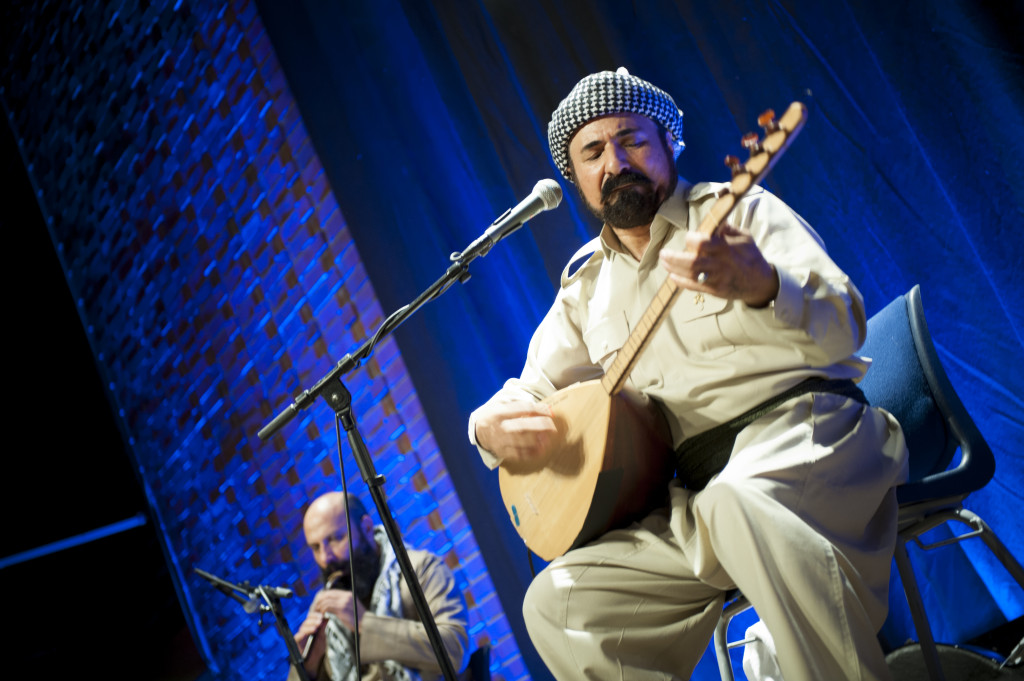Martin Longley on day two of Norway’s Førdefestivalen.
The Førdehuset also boasts several smaller theatre alternatives to its Sports Hall. On the Friday, at noon, the Iranian Vahdat sisters benefited from the intimate situation of the Idrettsalen, their band expanded from the previous day’s core of ney (wooden flute), setar (four-string lute) and daf (frame drum). They were joined by a trio of Norwegian players on hardanger fiddle, organ-piano and upright bass.
In their homeland, the Vahdats are not allowed to perform (since 1979, female singing in public has been forbidden), so they are now effectively exiled. Much of their repertoire is around 700 years old, but these poems can still be applied to modern existence. The Vahdats also delivered a few of their original works. A suspended state of introverted calm pervaded, with the sisters alternating between harmonies and solo sections. When the songs did raise their voices, this was still within a controlled landscape, passion contained for heightened quiet power.
The Norwegians at once immersed themselves in the Persian flow, but still provided an individual jazz frisson, with Nils Økland giving a particularly empathic solo, close to the end of the set. This was in tune with the ney, setar and daf players, who all received their own opportunities to shine, the songs very much open to instrumental interludes.
Another of the ‘produced’ concerts involved a ‘dream team’ of local folk players. The show was very carefully choreographed, with various permutations of artists shading from one to the next, often with a subtle glide. Fiddlers reigned, of course, but there were singers, accordionists, a saxophonist, and a team of dancers, who climaxed the show with a front-of-stage invasion, their moves an odd mixture of dignified grace, manly knee-cracking or shoe-slapping, and with some extreme spinning techniques that made the front row constantly fearful that bodies were going to come flying out of control. Somehow, this didn’t actually happen!
On the outside stage, the Amsterdam Klezmer Band found themselves playing in tough conditions, although the rain could have been much worse. Already, two of the major outdoor gigs had been forced to move indoors, but this one went ahead in the open. Even so, this band would have been more suited to an evening club environment, with drinking and close-quarter dancing.
They were visibly struggling to create the necessary mood, and succeeded quite well under the circumstances. They swapped around musical roles, changing lead singers, and delivering plenty of horn solos (saxophone, clarinet, trumpet and trombone). If they didn’t reach their peak state, it was still easy to imagine this combo’s exciting potential under prime circumstances.
Back in the Sports Hall, the Portuguese fado singer Ana Moura represented the glitzier aspects of this form, often sounding more like a mainstream pop artist. Her strength lay in the actual quality of her voice rather than the musical arrangements, with a notable gift for nimble phrasing, made even greater by the potential of Portuguese phonetics. She was spirited and charismatic, transcending some of the set’s questionable entertainment tactics and musical flourishes.
Another hot scene that it would have been easy to miss was the Columbi Egg session hosted by club-runner Gabriel Fliflet, hidden away in a small hotel sub-restaurant. He presented three acts for each evening, encouraging impromptu guest appearances. Trio Teriba used just their voices and drums, ending up by parading through the crowd, the atmosphere switching sharply when fiddler Astrid Sulheim played, quietening down into a gentle concentration. Then, MP3 kept the local folk feeling intact, but upped the activity towards a sprightly sprinting motion. The session concluded with Fliflet playing accordion, joined by fiddler Økland for a joyous spurt.
Each time that your scribe witnesses the Romanian gypsy band Taraf De Haïdouks, they’ve surely been getting faster and faster. The playing is so well-greased that they negotiate their tunes at an almost ridiculous rate, making dancing a supreme challenge. Their cimbalom (table-zither) spatulas skitter, fiddles scamper, flute zips, and their voices climb a plateau of exhilarating expressivity. One king-of-excess number lasted around 20 minutes, and came on like some monstrous cartoon symphony of compression.
To be continued.
